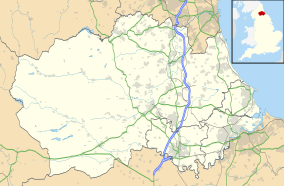Derwent Gorge and Horsleyhope Ravine facts for kids
Quick facts for kids Derwent Gorge andHorsleyhope Ravine |
|
|---|---|
| Location | Derwentside Tynedale, North East, England |
| Area | 83 ha (210 acres) |
| Established | 1976 |
| Governing body | Natural England |
| Website | Map of site |
The Derwent Gorge and Horsleyhope Ravine is a special natural area in North East England. It's located across two different districts: Derwentside in north County Durham and Tynedale in south Northumberland. This site is officially known as a Site of Special Scientific Interest (SSSI). This means it's a place that has important plants, animals, or geological features that need to be protected.
The area is made up of two separate parts, both covered in woodland. One part is in the deep valley, or gorge, of the River Derwent. The other part is in the ravine (a smaller, narrower valley) of the Horsleyhope Burn. The Horsleyhope Burn is a small river that flows into the River Derwent, making it a tributary. This beautiful natural spot is found south-east of the village of Muggleswick.
What is a Site of Special Scientific Interest?
A Site of Special Scientific Interest (SSSI) is a protected area in the United Kingdom. These sites are chosen because they have some of the best examples of wildlife, geology, or landforms in the country. Protecting them helps make sure these important natural places can thrive for a long time. The Derwent Gorge and Horsleyhope Ravine was given this special protection in 1976.
Exploring the Woodlands
The woodlands here are very interesting! On the higher parts of the slopes, where the soil is dry and a bit acidic, you'll mostly find sessile oak trees. These are a type of oak tree known for their acorns growing directly on the twigs, not on stalks.
Trees and Their History
Some parts of the woodland have been managed by people in the past using a technique called coppicing. Coppicing is when trees are cut down to near ground level. This makes them grow many new shoots from the stump. This method was often used to produce wood for different purposes, like fencing or fuel.
However, in the steepest and hardest-to-reach parts of the gorge and ravine, it looks like humans haven't interfered much at all. These areas are like wild, untouched forests, showing how nature can grow without human help.


